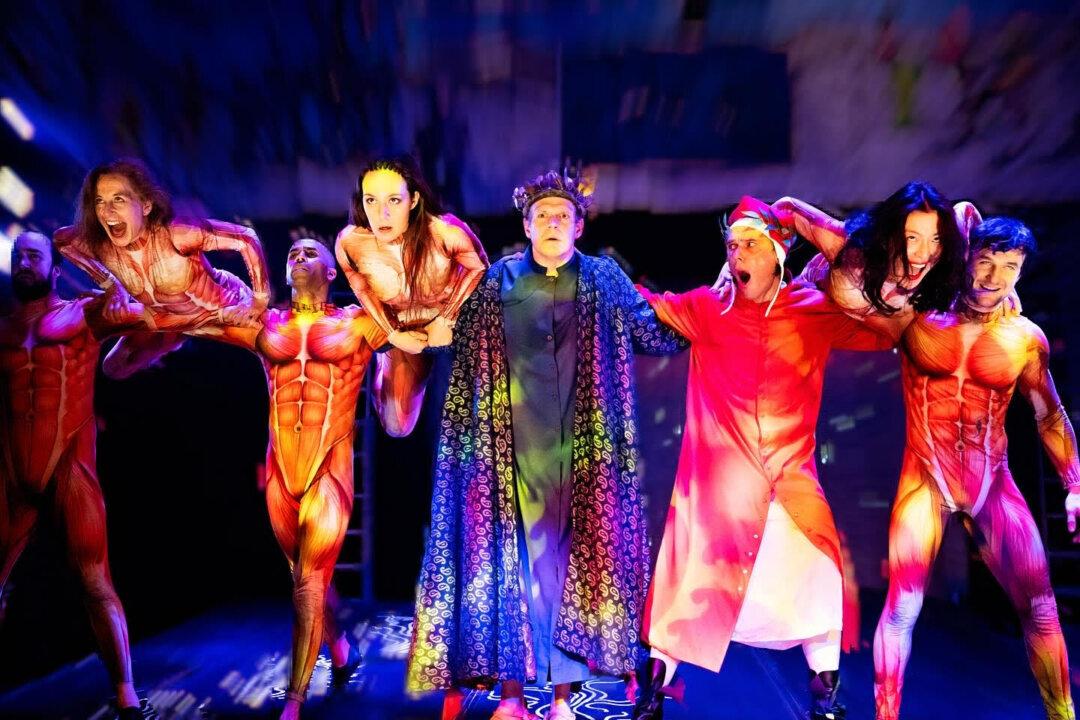NEW YORK—When I mentioned I was going to see “The Inferno,” the initial response was, “Why on earth would you want to go and see a play about Hell?”
For me, the Theater 86’s production was a chance to see a rare onstage performance of a traditional Western classic—with a modern touch. Critically acclaimed Russian director Aleksey Burago and producer pianist and actress Di Zhu adapted it for the stage using Robert Torrance’s recent translation.
Dante’s monumental “The Divine Comedy” trilogy describes Dante’s descent into Hell, Purgatory, and eventually Paradiso—heaven. This performance is based on the first part, “The Inferno.”
“The Divine Comedy” has been hailed as one of the all-time greatest contributions to Western literature. Written in Italian in the 14th century, the long poem is woven with “terza rima,” a complex iambic rhyming scheme that Dante himself created. The scheme consists of stanzas with three lines; the number three supposedly represents the Holy Trinity.
The Journey
Mr. Torrance’s English translation maintains the terza rima form. It sounds like Shakespearean verse and is often hard to follow.Dante’s journey takes him through the depths of Hell where he is introduced to many characters—most of whom Dante knew personally in life. These characters describe their sins and their reasons for being there.
Dante’s lost and deceased love, Beatrice (Ms. Zhu), sets the stage with her haunting introduction of Virgil, the Roman poet who was a lifelong inspiration for Dante, and who serves as Dante’s guide. Virgil appears out of the darkness, descending a stairway, to explain the nine circles of hell and explore the various sins attributed to each level.

Dante’s text mixes Roman Catholic culture and Greek mythology. Virgil and Dante meet an array of mythical creatures along the way—for example, Medusa and Centaurs—until the final descent to the pits of Hell. There at the bottom, they meet Satan. He holds Brutus and Cassius—Julius Caesar’s assassins—and the man who betrayed Jesus, Judas Iscariot.
I found the journey quite enlightening. Exploring all the sins of Hell, understanding that a higher power directs things, and the fact that there are consequences for our actions gave me a sense of a moral world.
The Performance
With next to no budget, just eight cast members, and hardly any props, the venture is impressive. Of the few props, the most notable is an inflatable bubble ball that encases Beatrice, illuminating her. She stands out from the darkness and the effect seems to show a field protecting her from Hell.
At the back of the stage, a video screen created by Ms. Zhu plays a mixture of atmospheric visions to enhance the scenes. Sometimes, it shows still images of woods, and so on. Other times, the audience sees some of 19th-century artist Gustave Doré’s illustrations to show where Dante and Virgil are on their journey. It also takes on an interactive quality, when actors dance behind it. The most memorable occasion is an image of Medusa’s head, with the actors waving their legs behind the screen to create the image of her serpent-like hair.
Dante, Virgil, and Beatrice’s costumes are in a very period style that’s true to their depictions in the Doré’s illustrations; this gives these characters authenticity. The rest of the cast—the inhabitants of Hell—are most often wear bodysuits to look like bodies without skins, adding a tone of spookiness--particularly the Malebranche, the evil demons that guard Bolgia Five of the Eighth Circle of Hell. Their duty is to prevent corrupt politicians from escaping from the boiling lake of pitch.
The music adds a modern twist, since it includes variations on songs like Police’s “Every Breath You Take” and Bonnie Tyler’s “Total Eclipse of the Heart.” These songs enhance the theme of Dante’s obsession with Beatrice, who is said to represent divine love; she’s his guiding light along his journey through the depths of hell and a symbol of Dante’s Christian faith.
Although often quite dark, the play contains comic elements to balance it out. Yet, overall, the play complies with a traditional theme of the tragedy where the viewer is forced to reflect on the terrors of Hell. If anything, the journey makes you want to be a good person.

So why go and see a play about hell. Well, actually, it’s about love, Mr. Burago says. “Dante said, you need to love.”
Mr. Burago and Ms. Zhu share a passion for classics, and it was their passion that brought this play to the stage. They take life as their inspiration for this adaptation.
What stood out for me most of all was the chemistry between the actors, which emanated throughout the performance. At 1 hour 40 mins, with no intermission, a play such as Dante’s “The Inferno” requires commitment, but I can’t help but feel I walked away a little wiser.
‘Dante’s Inferno’
Theater 86
165 W. 86th St., New York, NY
Tickets: 917-685-8491 or Theater86.com/dante
Runs: 1 hour, 40 minutes (no intermission)
Closes: May 4, 2024
Would you like to see other kinds of arts and culture articles? Please email us your story ideas or feedback at [email protected]






